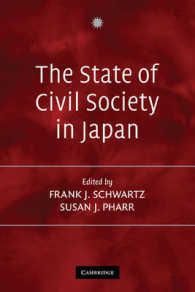- ホーム
- > 洋書
- > 英文書
- > Business / Economics
基本説明
New in paperback. Hardcover was published in 2005.
Full Description
Despite the successes achieved in liberalizing trade by multilateral trade negotiations sponsored by the World Trade Organization (WTO), numerous countries have separately negotiated preferential trade treaties with one another. Representing a significant departure from the WTO's central principle of non-discrimination among member countries, preferential trade blocs are the subject of an intense academic and policy debate. The first section of this 2005 book presents a rudimentary and intuitive introduction to the economics of preferential trade agreements. The following chapters present the author's theoretical and empirical research on a number of questions surrounding the issue of preferential trade agreements including the design of necessarily welfare-improving trade blocs, the quantitative (econometric) evaluation of the economic (welfare) impact of preferential trade liberalization, and the impact of preferential trade agreements and the multilateral trade system.
Contents
1. Introduction and overview: 1.1 Research objectives; 1.2 Outline; 2. The economics of preferential trade areas: 2.1 Trade creation and trade diversion; 2.2 Revenue transfer effects; 3. Necessarily welfare improving preferential trade areas: 3.1 Customs unions; 3.2 Non-economic objectives; 3.3 Free trade areas; 3.4 Implementation; 4. Geography and natural trading partners: 4.1 Modeling preferential trade liberalization: theory; 4.2 Modeling preferential trade liberalization: econometrics; 4.3 Data and estimation results; 5. Preferential trade agreements and multilateralism.







